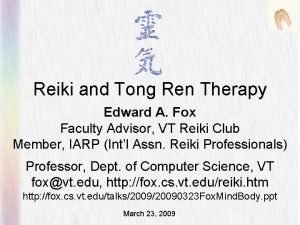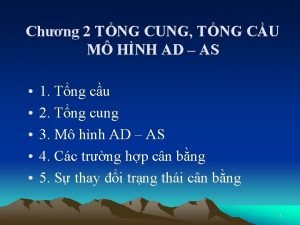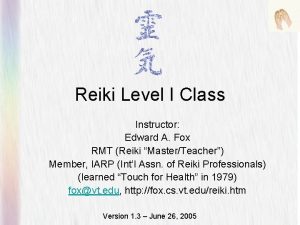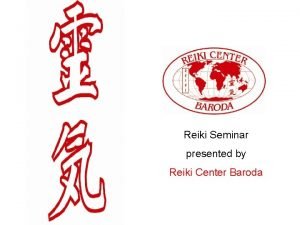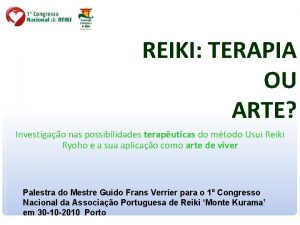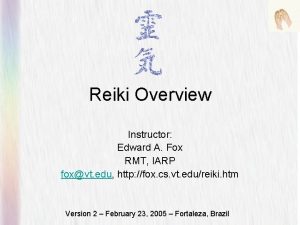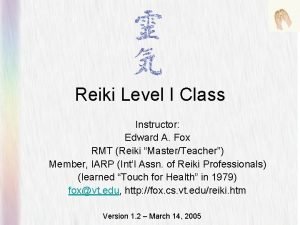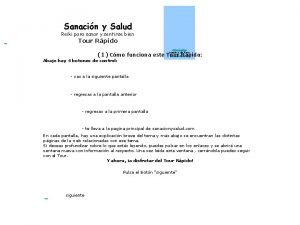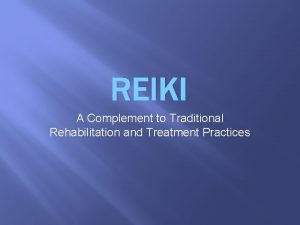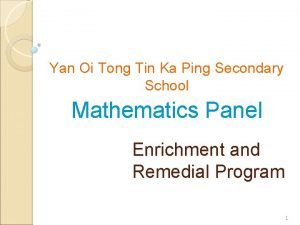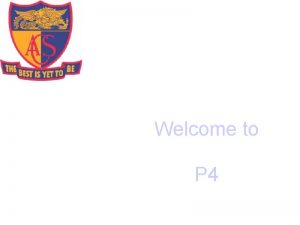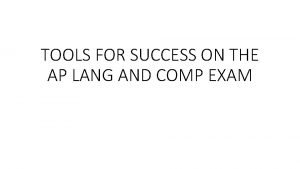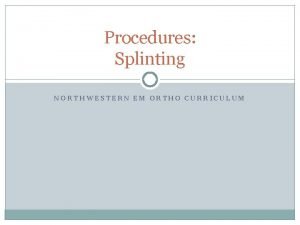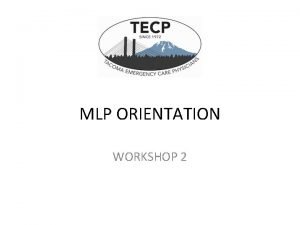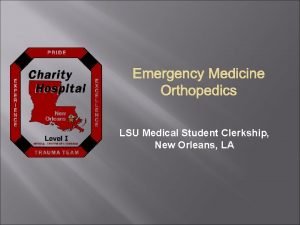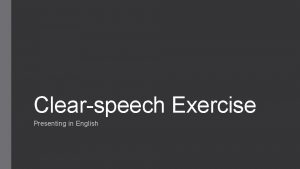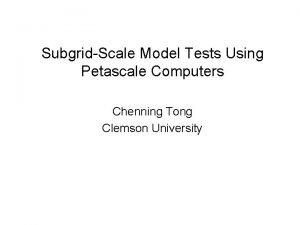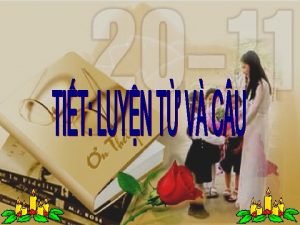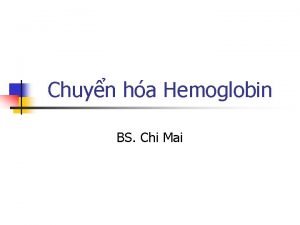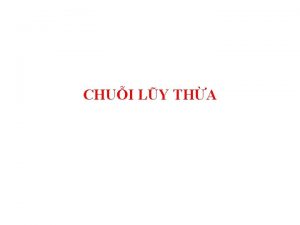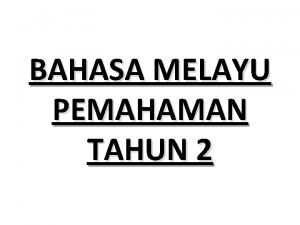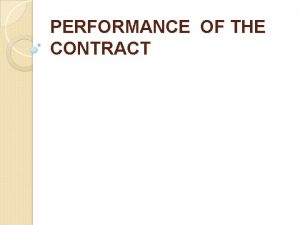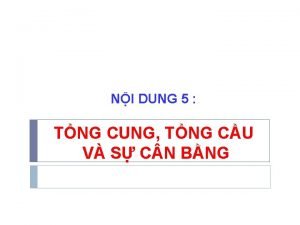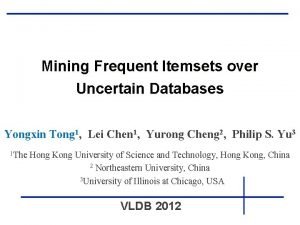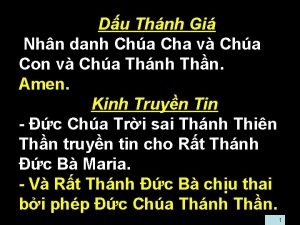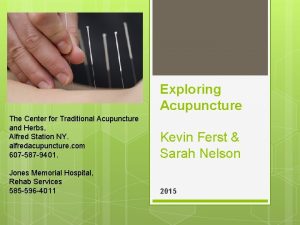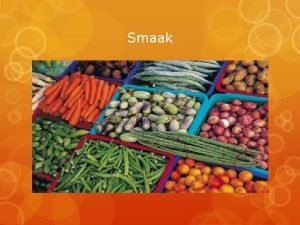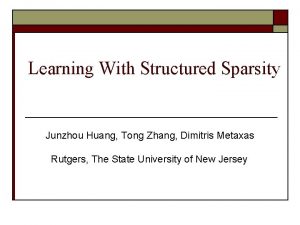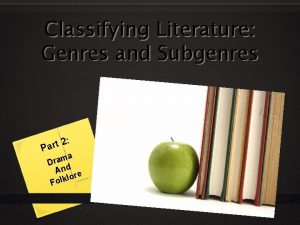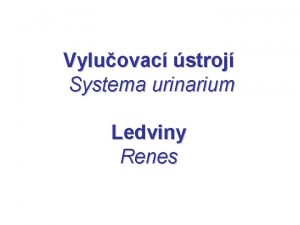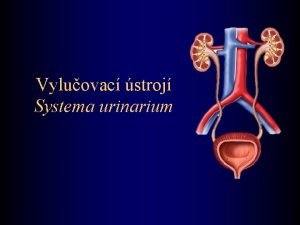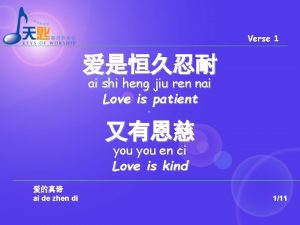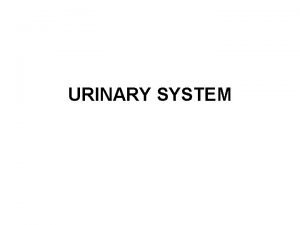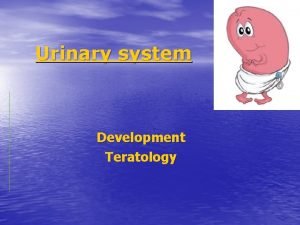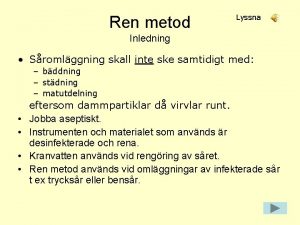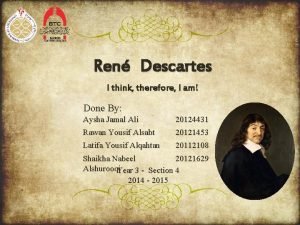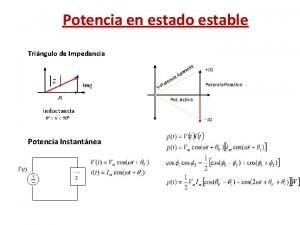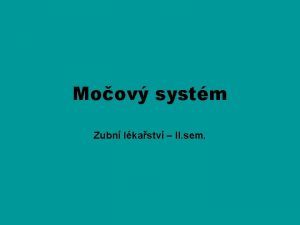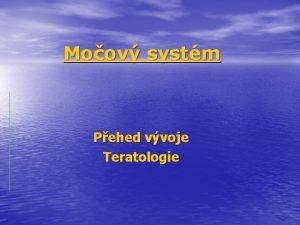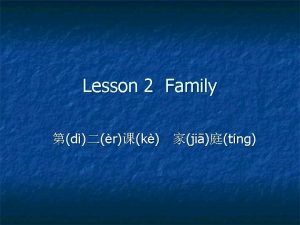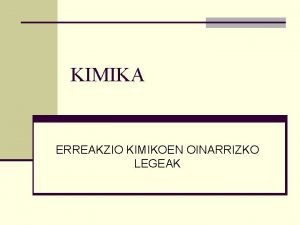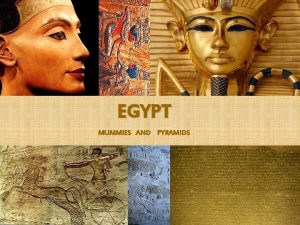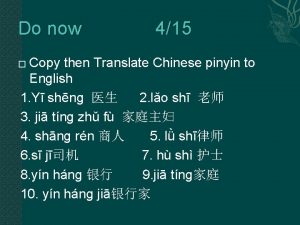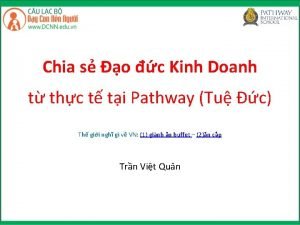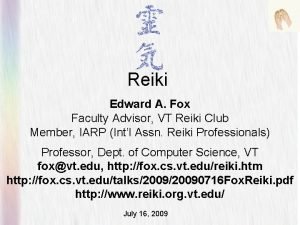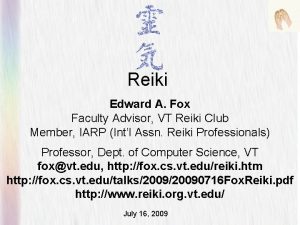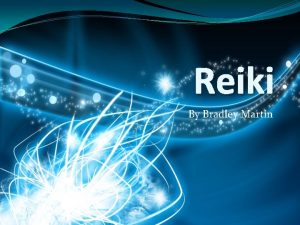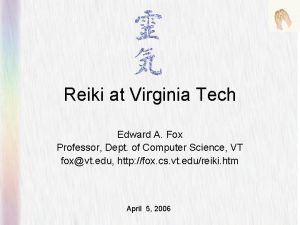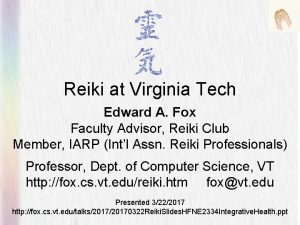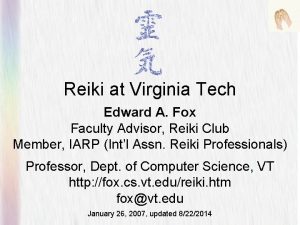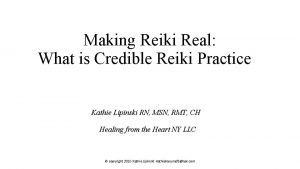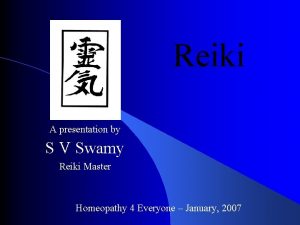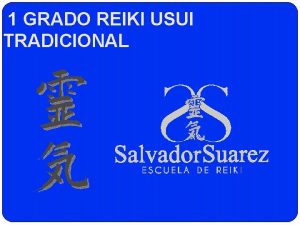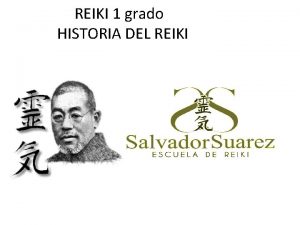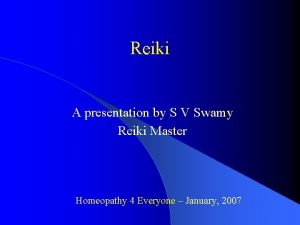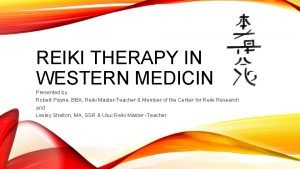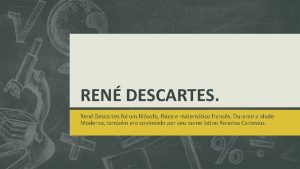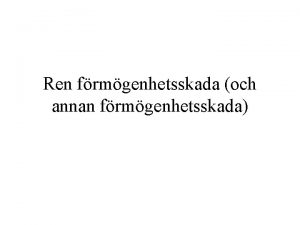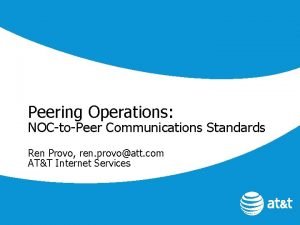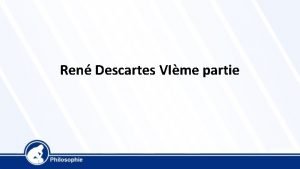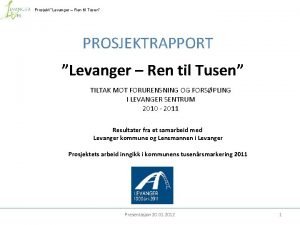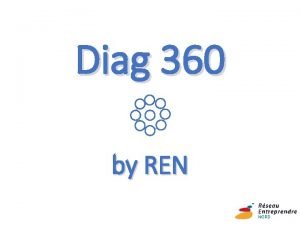Reiki and Tong Ren Therapy Edward A Fox


























































- Slides: 58

Reiki and Tong Ren Therapy Edward A. Fox Faculty Advisor, VT Reiki Club Member, IARP (Int’l Assn. Reiki Professionals) Professor, Dept. of Computer Science, VT fox@vt. edu, http: //fox. cs. vt. edu/reiki. htm http: //fox. cs. vt. edu/talks/20090323 Fox. Mind. Body. ppt March 23, 2009

Outline • Learning Objectives, Description, Initial Demonstrations, Terminology, Experience • Why Reiki, Clinical Trials, Energy Systems • Reiki Principles, History, Practice • Reiki Club, References, Studies, Web Sites • Tong Ren Therapy: Concepts, Focus Areas, Examples of Treatments, Information • Summary, Discussion, More Demonstrations

Learning Objectives, Description Learning Objectives 1. Students will be able to report on their perception of Reiki, and its effects. They will be able to discuss the hand positions and the Reiki approach to helping remove energy blockages and to improve energy flow. 2. Students will be able to describe the 5 Reiki principles, and the roles of Mikao Usui, Chujiro Hayashi, and Hawayo Takata in the history of Reiki. 3. Students will be able to explain Reiki attunements, and the 3 levels of Reiki, along with what types of practice are possible at those levels. 4. Students will be able to explain how Tong Ren therapy proceeds, and to discuss the underlying principles of how it can aid with healing. Description • We will explore the history, theory, principles, practice, and training methods associated with Reiki. • Connections will be drawn with other types of “energy healing”. • Students will gain hands-on exposure to Reiki practice, so most will have some sense of its effect.

Demonstrations • • Energy ball to set baseline Kenyoku-ho (dry bathing) Reiki Mawashi (Reiki Circle) Reiki practioners working with those interested • Energy ball to help with comparison

Kenyoku-ho (dry bathing) is a technique to clear and strengthen the energy channels. The technique was common to many martial arts and chi kung schools such as Ju. Jitsu, Aikido and Ki. Ko and was added by Usui. It is likely that this technique comes from the rituals of Shinto priests. The ritual action was to cleanse the body before contacting the deity. Those familiar with the martial arts will recognize the two parts of this technique as common techniques. The first is a down block across the midsection (this technique is used in a variety of martial arts such as Karate, Kung Fu, Aikido, etc. ). This down block is followed by what is commonly called in the martial arts as a "shirk" or technique to remove an opponents hand from your wrist that is done by sliding the knife edge of your hand down the arm. A. Place your right hand on the left shoulder so that the right fingertips are on the left shoulder. The hand is open, the fingers held together all point upwards. The hand (palm down) is against the body. B. Slide the hand downward toward the right hip. Move the hand, going across the chest and ending up fingers down at the right hip. The hand (palm down) stays in light contact with the body the entire movement. (This is what is called an open handed down block in the martial arts) C. Repeat this process starting with the left hand on the right shoulder and going down to the left hip.

Part Two D. Place the right hand again on the left shoulder. Slide the right hand down the left arm (inside or outside, each will cover different meridians - see below) all the way to the finger tips. (This is what would be called a "shirk" in the martial arts, used to remove an opponents hand that is grabbing your arm. ) E. Repeat this with the left hand on the right arm. F. Start with the right hand on the inside of the left elbow, and slide the hand down to the fingertips. G. Repeat this with the left hand on the right inside of the elbow. Note - Some masters teach the hand should slide to the inside of the arm and others teach it should slide down the outside of the arm. Different meridians are stimulated for each. The inside slide is yin and will effect the lung, heart, and kidney meridians. The outside slide is yang and will effect the triple warmer, colon and small intestine meridians.

Reiki Mawashi is commonly known as a Reiki Circle. This is a group of Reiki practitioners in a circle. The hands are held with your left hand palm up and your right palm down. Your left palm is placed against the next person's right hand that is palm down on top of it. All members are connected in this manner making a complete circle. The circle is part energy movement and part meditation. The Reiki flows from the crown down the right arm to the hand the overflow goes into the left hand of the person next to you. The energy moves into all and around the circle in this manner. The energy can be quite intense over time. Some traditions hold an inch to three inches between the participant's hands. Some traditions have a master stand in the center of the circle to direct the flow.

Terminology • Reiki = “universal life energy” (rei + ki) • Mikao Usui = founder of Reiki, associate / contemporary of those who founded karate and akido • RMT = Reiki “Master/Teacher” • Levels = 1, 2, 3 (at which point can teach) • Attunement = process of learning Reiki (tuning in, so you can channel energy)


Experience with “Energy Work” • Acupressure since 1979 (“Touch for Health”) • Reiki: 100 s of attunements, 1000 s of hours practice • Practiced/taught/collaborated in a number of countries: – – – – Brazil, China England, Germany Greece, Hungary India, Italy Malaysia, Netherlands Russia, Sweden USA, Vietnam

Why Reiki? • Reiki is very easy to learn; anyone can do it. • Those trained can help themselves and others (including animals and humans). • It can promote health, healing, and emotional/mental/spiritual development. • It can lead to benefits of acupuncture, hatha and kundalini yoga, homeopathy, qigong, and other types of “energy medicine”.

NCCAM Clinical Trials • Efficacy of Reiki in the Treatment of Fibromyalgia • Effects of Reiki on Painful Neuropathy and Cardiovascular Risk Factors • The Use of Reiki for Patients with Advanced AIDS • Reiki/Energy Healing in Prostate Cancer • Effects of Reiki on Stress • http: //clinicaltrials. gov/search/term=(NCCAM)+% 5 BSPONSOR%5 D+(reiki)+%5 BTREATMENT% 5 D? recruiting=false

Terms related to “Energy” • • • Aura Biological energy (Wilhelm Reich) Chi, Ki, Qi (China, Japan) EMF (electromagnetic force) HEF (human energy field) Huna (Hawaii) Prana (India) Spirit (Jesuit translation of Chinese “Qi”) Vital force (homeopathy)

Measurement of “Energy” • • • Electrocardiogram, electroencephalogram Magnetoencephalograph, SQUID Galvanic skin response (acupoints) Kirlian photography Gaseous Discharge Visualization (GSV) • Or by skilled human practitioners: – Reiki, Traditional Chinese Medicine (e. g. , pulse check), Therapeutic Touch

Aura, Human energy field, Human energy system


Chakras vs. Nervous System Number, Gland Chakra Nervous System 7 pituitary Crown Brain upward 6 pineal Brow (3 rd eye) Brain 5 (para)thyroid Throat Cervical plexus 4 thymus Heart Cardiac plexus 3 pancreas Solar plexus 2 gonads Hara (center) Pelvic plexus 1 adrenals Root Sciatic plexus

Chinese: Acupoints, Meridians

Reiki History • August 1865: Mikao Usui born in Gifu prefecture in Japan • March 1922: Usui experienced spiritual awakening at 3 rd wk fasting Mt. Kurama, Kyoto; named healing as Reiki Ryoho • March 1926: Usui-sensei passed away in Fukuyama • Chujiro Hayashi (1879 -1940) • Western Reiki: Hawayo Takata (1900 -1980), Phyllis Furumoto, …

Usui Reiki Principles Version a: For today only • anger not, • worry not. Version b: Just for today • do not worry, • do not anger. • Be humble, and • • With Gratitude work on yourself. Treat others with respect and forgiveness. • Work with integrity. • Be grateful. • Be Compassionate.

Gassho is a common practice in many eastern traditions, holding the hands clasped in a “prayer position” at about the level of the chest. It is called "Namaste" in the Indo-Tibetan traditions. In Reiki, Gassho is formally practiced by sitting on the floor or on a chair, with the eyes closed. The hands are in the prayer clasped position with the fingers touching in front of the chest; this completes the meridians that terminate in the hands.

Attunement • Opens Chakras: – Crown, Brow, Throat, and Heart Chakras – Hand Chakras – to heal self / others • Teacher: – transmits energy so student will “tune in” – walks to back and front – affirmations that student becomes attuned • Student: – hands in “prayer position” – “return” when ready, drink extra water

Reiki Hand Positions

IARP Code of Ethics for Registered Practitioners The Registered Practitioner (RP) agrees to: 1. Abide by a vow of confidentiality. Any information that is discussed within the context of a Reiki session is confidential between the client and the Practitioner. 2. Provide a safe and comfortable area for client sessions and work to provide an empowering and supportive environment for clients. 3. Always treat clients with the utmost respect and honor. 4. Provide a brief oral or written description of what happens during a session and what to expect before a client's initial session. 5. Be respectful of all other's Reiki views and paths.

6. Educate clients on the value of Reiki and explain that sessions do not guarantee a cure, nor are they a substitute for qualified medical or professional care. Reiki is one part of an integrated healing or wellness program 7. Suggest a consultation or referral to qualified licensed professionals (medical doctor, licensed therapist, etc. ) when appropriate. 8. Never diagnose or prescribe. Never suggest that the client change prescribed treatment or interfere with treatment of a licensed health care provider. 9. Never ask clients to disrobe (unless in the context of a licensed massage therapy session). Be sensitive to the boundary needs of individual clients. Do not touch the genital area or breasts. Practice hands off healing of these areas if treatment is needed. 10. Be actively working on your own healing so as to embody and fully express the essence of Reiki in everything that you do.

What Can Reiki Do? • • Sense energy “blockages” Clear an acupoint Clear a meridian Clear a chakra Clear the aura Speed up healing Help ground, calm, relax, reduce pain Non-invasive help to body internals – Work on an organ or gland

VT Reiki Club • • • http: //www. reiki. org. vt. edu/ reiki@vt. edu Wednesdays, 5 -7: 30 pm, Squires Open to public Free “treatments” and “attunements”

Book: Reiki, Hospice • Reiki Energy Medicine: Bringing Healing Touch Into Home, Hospital, and Hospice • By Libby Barnett and Maggie Chambers, with Susan Davidson • http: //books. google. com/books? hl=en&id=Ipeziekqc. WQC& dq=reiki+hospice&printsec=frontcover&source=web&ots=1 ge. Rnwp. Lir&sig=HQ 1 Xo. D 2 Awsn. IMQIsol. Ocvk. Lt 0 aw • This book is discussed in an online article at • http: //www. socialworktoday. com/archive/swt_0304 p 28. htm • Reiki - Rising Star in Complementary Care Social Work Today By Kate Jackson Vol. 4 No. 3 p. 28

References: Reiki, Hospice • Reiki: A complementary therapy for life; Bullock, Marlene RN BSN, American Journal of Hospice and Palliative Care, Jan 1997, Vol 14(1) pp 31 -32 • http: //www. reikiinhospitals. org/ - Reiki in Hospitals – can join for free and then get resources about Reiki use in hospice … • http: //www. rainbowhospice. org/news/article. asp? A RTICLE_ID=57 - Rainbow Hospice site discussion about Reiki for hospice • http: //www. joyousjournies. com/reiki. Hospice. html - Reiki at the end of Life: My Experience - By Wendy Jordan, Reiki Master & Teacher

Reiki References - Getting Started • Vennells, David F. Beginner’s Guide to Reiki. Barnes and Noble, New York, 1999. ISBN 0 -7607 -3798 -3 • Jewell, Penelope. Reiki: A Guide to your Practice of Reiki Energy Healing. Latham, NY: Adirondack Press, 2003, ISBN 0 -9664072 -0 -2 • Ellis, Richard. Practical Reiki: Focus Your Body’s Energy for Deep Relaxation and Inner Peace. Sterling Pub. Co. , Inc. , New York, 1999. ISBN 0 -8069 -6807 -9. • Burack, Marsha. Reiki, Healing Yourself & Others: A Photo-Instructional Art Book. Reiki Healing Institute, Encinitas, CA: ISBN 1 -880441 -39 -X, 1995. • Lubeck, Walter, Frank Arjava Petter, William Lee Rand. The Spirit of Reiki. Lotus Press, Shangri-La; 2001, ISBN: 0 -914955 -67 -5, 200. (Has lots of guidance on treating various conditions - a good manual. )

Reiki References - Intermediate • Honervogt, Tanmaya (Reiki Master-Teacher). The Power of Reiki: An Ancient Hands-on Healing Technique. An Owl Book, Henry Holt and Company, New York, 1998, ISBN 08050 -5559 -2 • Honervogt, Tanmaya. Inner Reiki. New York: Owl Book, Henry Holt & Company, 2001. ISBN 0 -8050 -6690 -X. • Lübeck, Walter. Aura Healing Handbook. Lotus Press, Shangri-La; 1991 Germany, 2000 English, ISBN: 0 -91495561 -6 • Mc. Kenzie, Eleanor. Healing Reiki. Ulysses Press; ISBN: 1569751625 (November 1998) • Muller, Brigitte and Horst H. Gunther. A Complete Book of Reiki Healing. Life. Rhythm, Mendocino CA, 1995, ISBN 0940795 -16 -7 • Rowland, Amy Z. Traditional Reiki for Our Times: Practical Methods for Personal and Planetary Healing Arts Press, Rochester, VT, 1998. ISBN 0 -89281 -777 -1.

Reiki References - More Advanced • Stein, Diane. Essential Reiki: A Complete Guide to an Ancient Healing Art. The Crossing Press, ISBN 0 -89594736 -6, 1995. • Usui, Dr. Mikao and Frank Arjava Petter, Foreword by William Lee Rand. The Original Reiki Handbook of Dr. Mikao Usui. Translated by Christine M. Grimm, Lotus Press, Shangri-La, 2000, ISBN 0 -914955 -57 -8 • Kelly, Maureen J. Degrees of Reiki. Twin Lakes, WI: Lotus Press, 2002, ISBN 0 -940985 -56 -X • Lübeck, Walter, Frank Arjava Petter. Reiki Best Practices: Wonderful Tools of Healing for The First, Second, and Third Degree of Reiki. Lotus Press, Shangri -La; 2003, ISBN: 0 -914955 -74 -8 • Vennells, David. Reiki Mastery: For Second Degree Students and Teachers. O Books, 2004, ISBN: 1 -903816 -70 -X

Reiki References - Historical • Frank Arjava Petter, Tadao Yamaguchi, Chujiro Hayashi. The Hayashi Reiki Manual: Traditional Japanese Healing Techniques from the Founder of the Western Reiki System. Lotus Press, Shangri-La; 2003, ISBN: 0 -914955 -75 -6 • Usui, Dr. Mikao and Frank Arjava Petter, Foreword by William Lee Rand. The Original Reiki Handbook of Dr. Mikao Usui. Translated by Christine M. Grimm, Lotus Press, Shangri-La, 2000, ISBN 0 -914955 -57 -8 • Doi, Hiroshi. Modern Reiki Method for Healing. Fraser Journal Publishing, Canada, ISBN: 0 -9688100 -0 -4 • Stein, Bronwen and Frans. The Reiki Sourcebook. Alresford, UK: O Books, 2003, ISBN 1 903 816 55 6

Related References - Healing • Burger, Bruce. Esoteric Anatomy: The Body as Consciousness. North Atlantic Books, 1998, ISBN 1 -55643224 -0 • Brennan, Barbara Ann. Hands of Light, A Guide to Healing Through the Human Energy Field. Bantam, NY, ISBN 0 -55334539 -7, 1987 • Brennan, Barbara Ann. Light Emerging, The Journey of Personal Healing. Bantam, NY, ISBN 0 -553 -35456 -6, 1993 • Eden, Donna with David Feinstein (foreward by Caroline Myss). Energy Medicine. Penguin/Putnam, NY, 1999, ISBN 1 -58542 -021 -2 • Gach, Michael Reed. Basic Acupressure: The Extraordinary Channels & Points. Acupressure Inst. , Berkeley, 1999 • Gach, Michael Reed. Intermediate & Advanced Acupressure Course Booklet. Acupressure Inst. , Berkeley, 1984

Related References - Healing (cont. ) • Gienger, Michael. Crystal Power, Crystal Healing: The Complete Handbook. Cassell & Co, London, 2002, ISBN 0 -7137 -2677 -6 • Mitchell, Emma. Energy Now: Simple ways to gain vitality, overcome tension, and achieve harmony and balance. Macmillan, Singapore, 1998, ISBN 0 -02 -862675 -3 • Angelo, Jack. Hands-On Healing: A Practical Guide to Channeling Your Healing Energies; Healing Arts Press, Rochester, VT, 1997, ISBN 0 -89281 -734 -8 • Thie, John, Keith Marks (Photographer). Touch for Health: A Practical Guide to Natural Health Using Acupressure Touch and Massage to Improve Postural Balance and Reduce Physical and Mental Pain and Tension, De. Vorss & Company, Dec. 1979, ISBN: 0875161804

Related References - Animals • Zidonis, Nancy A. and Amy Snow. Acu. Cat: A Guide to Feline Acupressure. Tailgrass Publishers, Denver CO, 2000, ISBN 0 -9645982 -5 -6 • Zidonis, Nancy A. and Marie K. Soderberg. Canine Acupressure: A Treatment Workbook. Equine Acupressure, Parker CO, 1995, ISBN 0 -9645982 -0 -5

Related References - Science • • Gerber, Richard. Vibrational Medicine, 3 rd Edition, 2001. Bear & Company, Rochester, VT ISBN 187918158 -4 Jonas, Wayne B and Crawford, Cindy C. , ed. Healing, Intention, and Energy Medicine: Science, Research Methods and Clinical Implications. New York: Elsevier Science Ltd. , 2003. ISBN 0443 -07237 X. Oschman, James L. (with foreward by Candace Pert). Energy Medicine: The Scientific Basis. Churchill Livingstone (an imprint of Elsevier Science Ltd), Edinburgh, 2002, ISBN 0 -443 -06261 -7 Oschman, James L. Energy Medicine in Therapeutics and Human Performance. Butterworth Heinemann (an imprint of Elsevier Science Ltd), Philadelphia, PA, 2003, ISBN 0 -7506 -5400 -7 Pert, Candace B. Molecules of Emotion: Why You Feel the Way You Feel. New York: Scribner, 1997. ISBN 0 -684 -84634 -9 Benor, Daniel J. ; Healing Research: Holistic Energy Medicine and Spirituality; Volume 2: Holistic Energy Medicine and the Energy Body; Helix Editions, Munich, 1992, ISBN 3 -927930 -22 -9 Francomano, Clair A. and Wayne B. Jonas (ed. Ronald A. Chez); Proceedings: Measuring the Human Energy Field: State of the Science; The Gerontology Research Center, National Institute of Aging, National Institutes of Health, Baltimore, MD, April 17 -18, 2002

Sponsored Research Project • Sponsor: Argyll Foundation • Title: Relief for Canine Hip Dysplasia Related Pain through Reiki • PI: Marie Suthers-Mc. Cabe • Co-PIs: – Peter K. Shires – Edward A. Fox

Initial Vet School Project • • Selection: 2 years, 40+ lbs. , “arthritic hip” Force-plate lab (immediate measurement) Video record of dogs walking Screening: clinical exam, blood test, X-ray Treatment: 1 hour of Reiki Repetitions: 3 times, 3 week intervals Other observations: – Daily record by owner – Final examination at end of project • Sample: 6 each, control vs. treatment

Other VT Studies • Tissue cultures (Duca) – Hampster cells cultured in Petri dishes – Exposed to virus – Reiki: before, 1 day, 2 days, 3 days – Chart spread of virus vs. control • Infrared videography (Odendaal) – Hand chakra – Rapid rise in skin temperature – Local and distant treatment

Reiki Web Sites • http: //fox. cs. vt. edu/reiki. htm - my Reiki site, pointing to many sites • http: //www. iarp. org - the International Association of Reiki Professionals, of which I am a member. • http: //pjentoft. com/0 Reiki. html - good manuals and reference material.

Outline • Learning Objectives, Description, Initial Demonstrations, Terminology, Experience • Why Reiki, Clinical Trials, Energy Systems • Reiki Principles, History, Practice • Reiki Club, References, Studies, Web Sites • Tong Ren Therapy: Concepts, Focus Areas, Examples of Treatments, Information • Summary, Discussion, More Demonstrations

Tong Ren (TR) Therapy • Visit by Chad J. Dupuis, L. Ac. • Presentation of Feb. 3, 2006 for Virginia Tech Reiki Club • Based on collaboration with Tom Tam • Supported by acupuncture, qi gong, martial arts theory – further improved upon by western medical understandings of anatomy and physiology, and proven by clinical practice with a broad range of conditions.

Meridians and Points • The acupuncture meridians and points have been developed over many years by many masters. Some points previously used are not commonly remembered now. • Imbalances in the meridians signify underlying health problems. • The stimulation of the points and regulation of the meridians promotes health and healing of diseases.

Large Intestine Meridian

Western Medicine Aspects • Using the tools of Chinese Medicine and the (sense of) energy from Reiki or Qi Gong practice, one can better utilize western medical understandings for healing. • A variety of acupuncture points have been proven to directly stimulate physiological functions of the body. Understanding this mechanism better and the result of such changes is behind TR.

Theories Unique To Tong Ren Therapy • The use of the collective unconscious • Blockage Theory – New Acupuncture Points/Areas – Sky windows and scalp points/areas new meanings • And, of course, the “tong ren”

Tong Ren Techniques • The “Tong Ren” or “Bronze Man” model serves as a way to focus our intent and to stimulate the collective unconscious. • The collective unconscious allows the effect to be present within the patient (and others at the same time). • The “blockage theory” provides the focus of the areas treated and removal of the blockages allows the body to heal.

Blockage Theory • Cancer, as an example: – Eastern – yin and yang are out of balance – Western – cells have mutated for some reason – Tong Ren – a “blockage” causes a disruption in the flow of energy and bioelectricity leading to disease.

Blockage Theory cont. • The existence of a “blockage” does not indicate disease per se, but a disease will not manifest without exhibiting a blockage. • Finding these blockages and devising the best mechanisms to resolve them is our goal. • The blockages can be sensed energetically, but also by palpation and will generally illicit pressure pain.

Focus Areas: the Spine • Use of the huatuo-jiaji points – the areas next to each vertebral segment. • Improve the flow of bio-electricity by reducing impediments to nerve conduction.

Focus Areas: Scalp • Use of acupuncture points on the scalp differs somewhat from TCM usage. • Tong Ren is used to change brain function as well as remove tumors.

Focus Areas: Sky Window • • Improve circulation to and from the brain. Stimulate the vertebral artery. Stimulate other nerves such as the vagus. Area contains acupuncture points that are poorly understood and infrequently used.

Breast Cancer Treatment • Main Points – T 4, ST 12, Ouch Point • Secondary Points – T 3, GV 22, BL 9, CV 17 – – – – T 4 – Breast, Sweat Glands, Hair follicles, PC Shu ST 12 – Open the chest Ouch Point – Qi Gong to dissipate tumor T 3 – Often added with T 4 – controls lung and skin GV 22 – Open the unconscious, effect frontal lobe UB 9 – Cerebellum, movement, open Qi flow CV 17 – Energize the upper dantian/chest

More Examples • Anxiety: C 2 r, GB 13 r, SI 16 r – T 5 l, LV 3, HT 7, Yiming, LI 18 – C 2 & GB 13 – frontal lobe/emotions (L for ADHD), SI 16/LI 18/Yiming free body/mind circulation, T 5 l heart, HT 7, effects HT Qi, LV 3 descend energy • Parkinson's: C 1, SI 16, TH 16, Tiandong – C 2, Yiming, LI 4, GV 19, ST 36, LV 3 – C 1, SI 16, TH 16, open sky window – brain/body, Tiandong vertebral artery, LI 4/LV 3 open circulation throughout body (4 gates), ST 36 tonify Qi, GV 19 sensory cortex

More Examples • MS: C 2, Tiandong, SI 16, TH 16 – C 1, Yiming, BL 9, GV 17, GB 19, ST 36 – Similar to Parkinson's & ALS, any brain problem (stroke, etc. ) • Crohn’s: T 1, T 2, T 3, T 11 – T 12, ST 12, CV 6, ST 36 – T 1/2/3 – autoimmune conditions, T 11/T 12 open SI/LI, ST 12 vagus/esophagus, CV 6 tonify lower dantian, ST 36 build qi

More Information • http: //www. yinyanghouse. com/ – General Chinese Medicine Theory – Acupuncture Meridians and Points – Tong Ren Therapy Information – Tong Ren Books and Supplies – Discussion Board with Testimonials – See also in You. Tube, Phone Conferences, …

Summary • Learning Objectives, Description, Initial Demonstrations, Terminology, Experience • Why Reiki, Clinical Trials, Energy Systems • Reiki Principles, History, Practice • Reiki Club, References, Studies, Web Sites • Tong Ren Therapy: Concepts, Focus Areas, Examples of Treatments, Information • Summary, Discussion, More Demonstrations
 Tong ren therapy pdf
Tong ren therapy pdf 2tng
2tng Kenyoku ho
Kenyoku ho Gary blonder
Gary blonder Reiki co to takiego
Reiki co to takiego Iarp reiki
Iarp reiki Shuchu reiki
Shuchu reiki Sanacin
Sanacin Reiki quackery
Reiki quackery Psychoanalytic therapy is to as humanistic therapy is to
Psychoanalytic therapy is to as humanistic therapy is to Bioness integrated therapy system price
Bioness integrated therapy system price What are the major humanistic therapies
What are the major humanistic therapies Yan oi tong tin ka ping primary school
Yan oi tong tin ka ping primary school Mdm teresa liew sin tong
Mdm teresa liew sin tong What is the difference between paradox and juxtaposition
What is the difference between paradox and juxtaposition Sugar tong splint wrist
Sugar tong splint wrist Pei tong primary school elite
Pei tong primary school elite Ulnar gutter splint
Ulnar gutter splint Little britain fish and chips
Little britain fish and chips Reverse sugar tong
Reverse sugar tong Lang tong
Lang tong English tong twister
English tong twister Công thức tổng quát của axit cacboxylic
Công thức tổng quát của axit cacboxylic Tong twister
Tong twister Chenning tong
Chenning tong Vua lý thánh tông
Vua lý thánh tông Tổng kết vốn từ 151
Tổng kết vốn từ 151 Sơ đồ quá trình thoái hóa hemoglobin
Sơ đồ quá trình thoái hóa hemoglobin Công thức bán kính hội tụ
Công thức bán kính hội tụ Tong ah perarakan
Tong ah perarakan Psle 2013
Psle 2013 Strathesk primary
Strathesk primary Smaakzintuigen
Smaakzintuigen Yong mok hin
Yong mok hin Https://slidetodoc.com/cc-ngun-m-c-chung-c-im-g/
Https://slidetodoc.com/cc-ngun-m-c-chung-c-im-g/ Yongxin tong
Yongxin tong Smaakzintuig
Smaakzintuig Kinh bởi trời và kinh vực sâu
Kinh bởi trời và kinh vực sâu Yao tong xue
Yao tong xue Mondgevoel betekenis
Mondgevoel betekenis Pei tong primary school
Pei tong primary school Tong zhang
Tong zhang The fox and the grapes genre and subgenre
The fox and the grapes genre and subgenre Fox and coyote and whale
Fox and coyote and whale Ansa nephroni
Ansa nephroni Excavatio rectovesicale
Excavatio rectovesicale Wu nai tiandi
Wu nai tiandi Margo lateralis renalis
Margo lateralis renalis Ren fungiformis
Ren fungiformis Ren metod
Ren metod Ren descartes
Ren descartes Factor de potencia formula
Factor de potencia formula Ren fungiformis
Ren fungiformis Ductus allantoideus
Ductus allantoideus Wo jia you liu kou ren
Wo jia you liu kou ren Lavoisier ren legea
Lavoisier ren legea Ren egyptian god
Ren egyptian god Translate image
Translate image T
T
